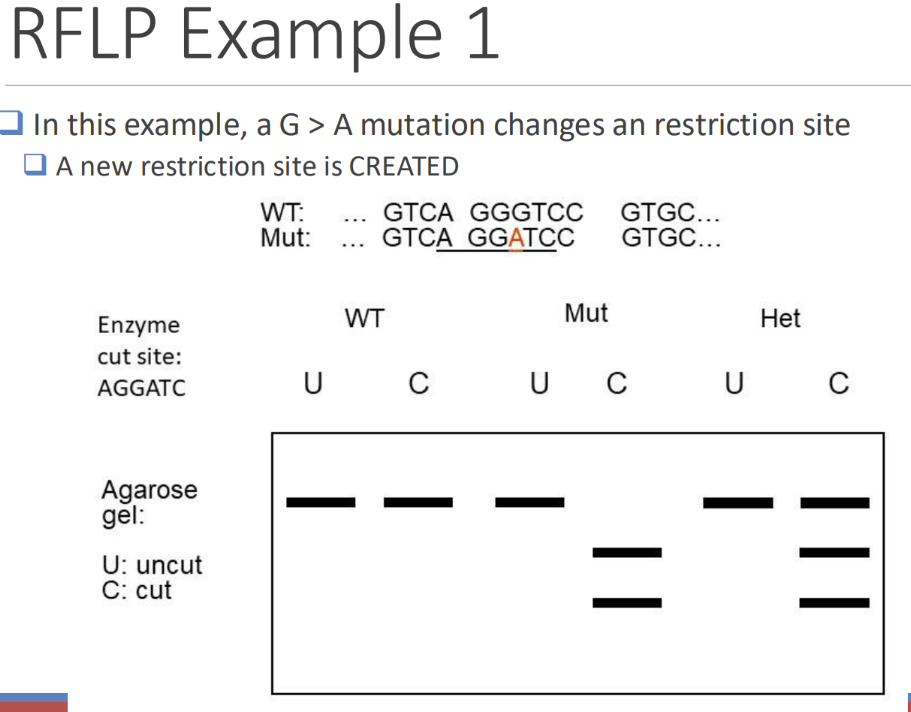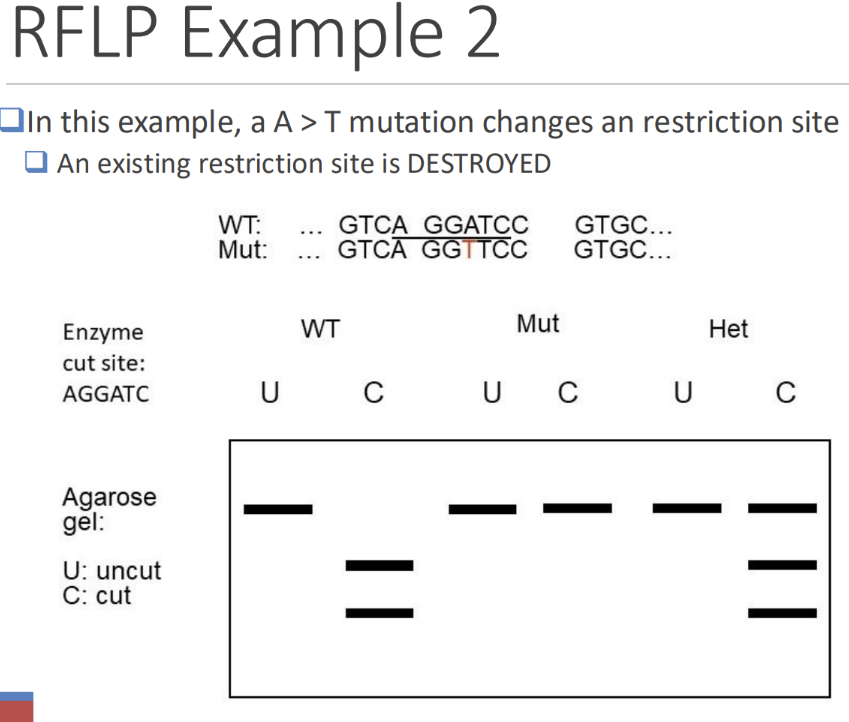Restriction Fragment Length Polymorphism Analysis (RFLP)
1/8
There's no tags or description
Looks like no tags are added yet.
Name | Mastery | Learn | Test | Matching | Spaced |
|---|
No study sessions yet.
9 Terms
What are the types of polymorphic DNA sequences
Types of polymorphic DNA sequences:
- SNP = Single nucleotide polymorphism (Alterations of a single nucleotide)
o Also known as SNV (single nucleotide variant)
o Single nucleotide change that may or may not be pathogenic
o Detection method = Sequencing, other
- VNTR = Variable number tandem repeats
o Detection method = Southern blot, PCR
- STR = Short tandem repeats
o Detection method = PCR
o Structure = repeats of 1-10 base sequences in tandem
- RLFP = Restriction fragment length polymorphisms
o These are alterations of the genome, often SNPs, that alter a restriction enzyme site sequence
o One or more nucleotide changes that affect the size of restriction enzyme products
o Detection method = Southern blot
What is RFLP
Restriction Fragment Length Polymorphisms (RFLP)
- Restriction fragment sizes are altered by changes in or between enzyme recognition sites
o Changes can prevent restriction enzymes from working (so need to have an idea how a normal sequence would look like with RE)
- Commonly used to assess SNPs, but can also detect insertions and deletions
- An RFLP assay requires detailed knowledge of the possible restriction sites within a locus and the likely alterations that occur due to mutation
- Today, RFLP is almost always done as PCR-RFLP, but traditional methods were done by blotting
- Observed as differences in the sizes and number of fragments generated by restriction enzyme digestion of DNA
o Fragment sizes vary as a result of changes in the nucleotide sequence in or between the recognition sites of a restriction enzyme
What are the steps to RFLP
Steps:
1. Construct a restriction enzyme map of the DNA region under investigation
2. Cut DNA with restriction enzymes
3. Gel electrophoresis
4. Blot on the membrane
5. Hybridize probes
6. Compare the number and sizes of the restriction fragments of a test DNA region cut with restriction enzymes are compared with the number and sizes of fragments expected based on the restriction map
7. Polymorphisms detected by observing fragment numbers and sizes different from those expected
What is a polymorphism
Polymorphism = a sequence difference compared to a reference standard that is present in at least 1-2% of a population
- Can be single bases or thousands of bases
- May or may not have phenotypic effects
- Found throughout the genome
- If the location of a polymorphic sequence is known, it can serve as a landmark or marker for locating other genes or genetic regions
- Each polymorphic marker has different versions or alleles
What is a SNP
Single-nucleotide polymorphism (SNPs)
- Single-nucleotide differences between DNA sequences
- One SNP occurs approximately every ~1250 base pairs in human DNA
- Every individual has ~11 million SNPs in their genome
- SNPs are detected by sequencing, melt curve analysis, or other methods
- 99% have no biological effect, ~60,000 SNPs are within genes


understand these examples
know how to do these examples

Steps of PCR-RFLP
PCR-RFLP
1. The locus of interest is amplified by PCR
2. The PCR product is subjected to digestion with the restriction enzyme of interest
3. The patterns of the resulting bands provide information about the presence or absence of mutations that alter the restriction site
4. Genotype can then be determined based on the prediction band sizes:
- Homozygous wildtype
- Homozygous mutant
- Heterozygous
When do you use PCR-RFLP
When to use PCR-RFLP
Any single-gene disorder that has a sequence variant is a potential candidate for a PCR-RFLP assay, with a few requirements:
- The variant must alter a restriction site (create or destroy) or alter the distance between restriction sites (insertions/deletions)
- The restriction site must be recognized by a commercially available enzyme with reasonable reaction conditions
Single gene disorders = these diseases can be assessed many other ways, such as hybridization-based methods, sequencing-based methods, and other PCR-based methods (RFLP is just one tool in the tool-box and is relatively cheap and easy)
- Lysosomal storage diseases, Factor V Leiden, Prothrombin, MTHFR, Hemochromatosis, Cystic fibrosis, etc.
What should be taken into account for PCR-RFLP
Other considerations:
- There are potentially hundreds to thousands of different restriction sites in a given PCR product
- There is a good chance that the chosen restriction enzyme picked for the assay will cut in other places in the PCR product besides the locus of interest
o Can even be found within the PCR primer-binding site
- There are “non-informative” restriction enzyme sites
o They will be cut, and the resulting fragments will be found in both mutant and wildtype